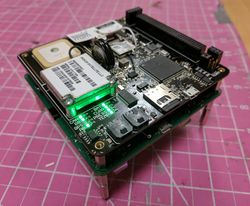Difference between revisions of "Balloons Gen 4 Avionics"
| Line 58: | Line 58: | ||
== Schematics == | == Schematics == | ||
| + | |||
| + | |||
| + | |||
| + | <gallery widths=200px heights=200px> | ||
| + | File:thecount_top.PNG | <center> Top Sheet </center> | ||
| + | </gallery> | ||
[[Category: High Altitude Balloons]][[Category: HABEES]][[Category: HONEY]] | [[Category: High Altitude Balloons]][[Category: HABEES]][[Category: HONEY]] | ||
Revision as of 03:13, 23 August 2017
| The Count | |
|---|---|
| Part of the HONEY Architecture series & the HABEES series | |

| |
| Chief Designer | Kirill Safin |
| Technology Line | Balloons Core Avionics |
| Version | Generation IV |
| Name | The Count |
| General | |
| HONEY Standards • Venom Breakout • Fang Breakout • Board Naming | |
| Core Software | |
| STINGR | |
| Core Avionics | |
| The Count | |
| Core Power | |
| Biscuit | |
| Core Peripherals | |
| Cobra • Viper • ProtoBee | |
| Core Radio | |
| Macaw | |
| Test & Prototype | |
| QueenBee | |
| Guides | |
| Making a HONEY Board • Using STINGR • Using QueenBee • Making a Prototype | |
| V • E | |
The Count is the fourth and final revision of the HABEES Standard Avionics Platform. It is the first of the standard avionics line to be HONEY-compliant and is, ultimately, the first board to be HONEY-compliant at all. Considerations for The Count, as it was meant to be the final avionics board, necessitated thought about the HABEES Core Architecture, which resulted in the implementation and development of HONEY.
The Count provides a variety of systems deemed to be essential for a standard balloon flight, as well as a number of other non-essential, but very useful, utilities. The Count features:
- A Teensy 3.6 embedded Microcontroller
- A ublox-M8Q GNSS (GPS/GLONASS/Beidou/Galileo) receiver with embedded patch antenna
- An Iridium 9603 embedded satellite communications modem, with embedded antenna.
- As well as super capacitor & required power circuitry
- MicroSD data logging
- A watchdog for hard-resets of MCU
- A thermocouple for external temperature sensing
- Two BMP280 pressure/temperature sensors, and one MPL3115A2 sensor
- A BNO055 9-dof IMU (accelerometer, gyro, magnetometer, and sensor fusion)
- A PWM-operated cutdown FET
- An inboard heater
- HONEY compliant power, CAN, and power bus connectors
- 8 RGB indicator LED's about various system states
- A power-selector to enable 5V operation from BMS or USB
- Two CAN Transceivers for use with the HONEY CAN bus
- Additional bypass capacitors
- Current sensors for GPS, Cutdown & Heater FETs, and Iridium module.
Development
The Count was developed as a high-end standard avionics platform, featuring a rich and comprehensive suite of sensors and utilities. It is meant to act as the standard avionics platform on all flights of the HONEY Stack, but can alternatively also be swapped out with Big Bird by compromising some functionality and utility.
The Count retained most core functionality of its predecessor, Elmo, and made some additions and changes to those systems, namely:
- The 9603 RockBlock Modem (over wire) was swapped out for a smaller, and embedded, 9603 modem
- The uBlox NEO-M8Q GPS added an embedded antenna over a connectorized one
- The IMU was updated to fix a reset bug
- HONEY-compliance was added and the architecture/form-factor was altered
- A power-selecting diode-OR was added to select between BMS or USB 5V power
- Large bypass capacitors were added to the overall system 5V/3.3V lines and GPS 3.3V
- The watchdog was given additional bypass capacitors
- A standard Teensy 3.2 was swapped out for an embedded Teensy 3.6
- A second CAN Transceiver was added.
Testing
Initial reflow and assembly of The Count featured countless problems. The 3.3V line contained a hard-short to GND; many attempts were made to determine the source of this short, and essentially all IC's were taken off and the short remained. A problem was identified that involved the Teensy 3.6 MCU. After about 20 hours of debugging the initial reflowed board, the attempt was abandoned in exchange for reflowing a new board -- system by system.
A new PCB of The Count was reflowed with only the Teensy 3.6 and necessary support systems. Once shorts were cleared, the Teensy 3.6 was verified and programmed. After this, system-by-system was added to the board by manually reworking it -- verifying each system after addition. Slowly but surely, all systems came online successfully and the board was verified.
Issues
The Count Rev 1 featured a number of small mistakes/issues that impeded its full functionality.
The first large mistake is that of the GPS antenna -- the post-LNA RF signal was fed into the uBlox GPS VCC_RF pin rather than the RF_IN pin; this prevented the onboard antenna from being used. A formerly used passive connectorized antenna was stripped and soldered to the GPS RF_IN pin to provide GPS functionality.
The second issue is that of the Iridium 9603 modem, which, as of time of writing, has not been verified to work. Testing suggests it is receiving appropriate power, but the module does not respond to any ACKs from the MCU.
The small final issue is that of the heater trace, which is roughly 100 ohms rather than the intended 10-20.
Schematics
- Thecount top.PNG
Top Sheet